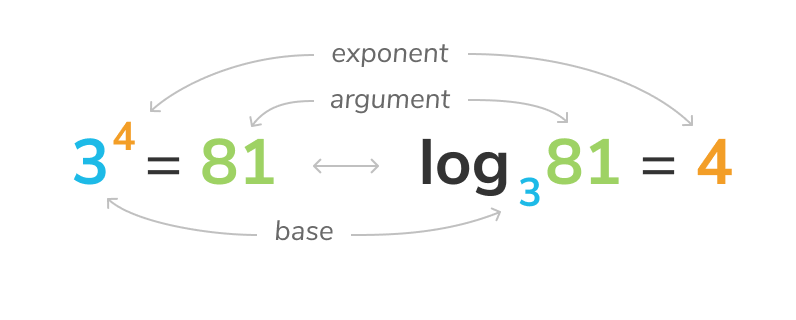Tiger Algebra Calculator
Logarithms
Logarithms answer the question: "what exponent do we need to raise a specified number by to turn it into another specified number ?" or, more simply, "how many times do we need to multiply a number by itself to get another specified number ?" For example: What exponent do we need to raise by for it to become or how many times do we need to multiply by itself to get ? The answer is , making the equation for this problem . Spoken out loud, this would be: "the logarithm of with base equals or log base of is or the base log of is .
The number that we multiply by itself is called the base of the logarithm. In our example, is the base of the logarithm.
The number between the base and the = sign is called the argument and is the number we get when we raise the base of the log () to the equation's solution (). In our example, is the argument.
The solution of the log is the exponent to which we raise the base of the log to get the logarithm's argument. In our example, is the solution.

A logarithm written with no base usually has a base of and is called a common logarithm. For example,
The log button on calculators inputs the common logarithm.
Natural logarithms, on the other hand, are written as ln and are logs with a base of . In this context, represents Euler's Number, an irrational number that equals approximately 2.7182. We can input a natural logarithm on a calculator by pressing the ln button.
Logarithms can also be positive or negative and include decimals.
Properties of logarithms with the same base:
Product rule:
Quotient rule:
Power rule:
Inverse rule:
Equality rule: If then
Changing of base properties:
The relationship between logarithms, exponents, and roots:
If we wrote an exponential equation three times, each time replacing a different value with a variable, we would get three very different, but closely related equations.
Let's look at the exponential equation: .
Scenario 1: Replacing the solution with a variable
Replacing the solution with would give us , which simplifies to
Scenario 2: Replacing the exponent with a variable
Replacing the exponent with would give us , which is a logarithmic equation that could be rewritten as and simplified as
Scenario 3: Replacing the base with a variable
Replacing the base with would give us , which could be rewritten as and simplified as
The number that we multiply by itself is called the base of the logarithm. In our example, is the base of the logarithm.
The number between the base and the = sign is called the argument and is the number we get when we raise the base of the log () to the equation's solution (). In our example, is the argument.
The solution of the log is the exponent to which we raise the base of the log to get the logarithm's argument. In our example, is the solution.

A logarithm written with no base usually has a base of and is called a common logarithm. For example,
The log button on calculators inputs the common logarithm.
Natural logarithms, on the other hand, are written as ln and are logs with a base of . In this context, represents Euler's Number, an irrational number that equals approximately 2.7182. We can input a natural logarithm on a calculator by pressing the ln button.
Logarithms can also be positive or negative and include decimals.
Properties of logarithms with the same base:
Product rule:
Quotient rule:
Power rule:
Inverse rule:
Equality rule: If then
Changing of base properties:
The relationship between logarithms, exponents, and roots:
If we wrote an exponential equation three times, each time replacing a different value with a variable, we would get three very different, but closely related equations.
Let's look at the exponential equation: .
Scenario 1: Replacing the solution with a variable
Replacing the solution with would give us , which simplifies to
Scenario 2: Replacing the exponent with a variable
Replacing the exponent with would give us , which is a logarithmic equation that could be rewritten as and simplified as
Scenario 3: Replacing the base with a variable
Replacing the base with would give us , which could be rewritten as and simplified as
